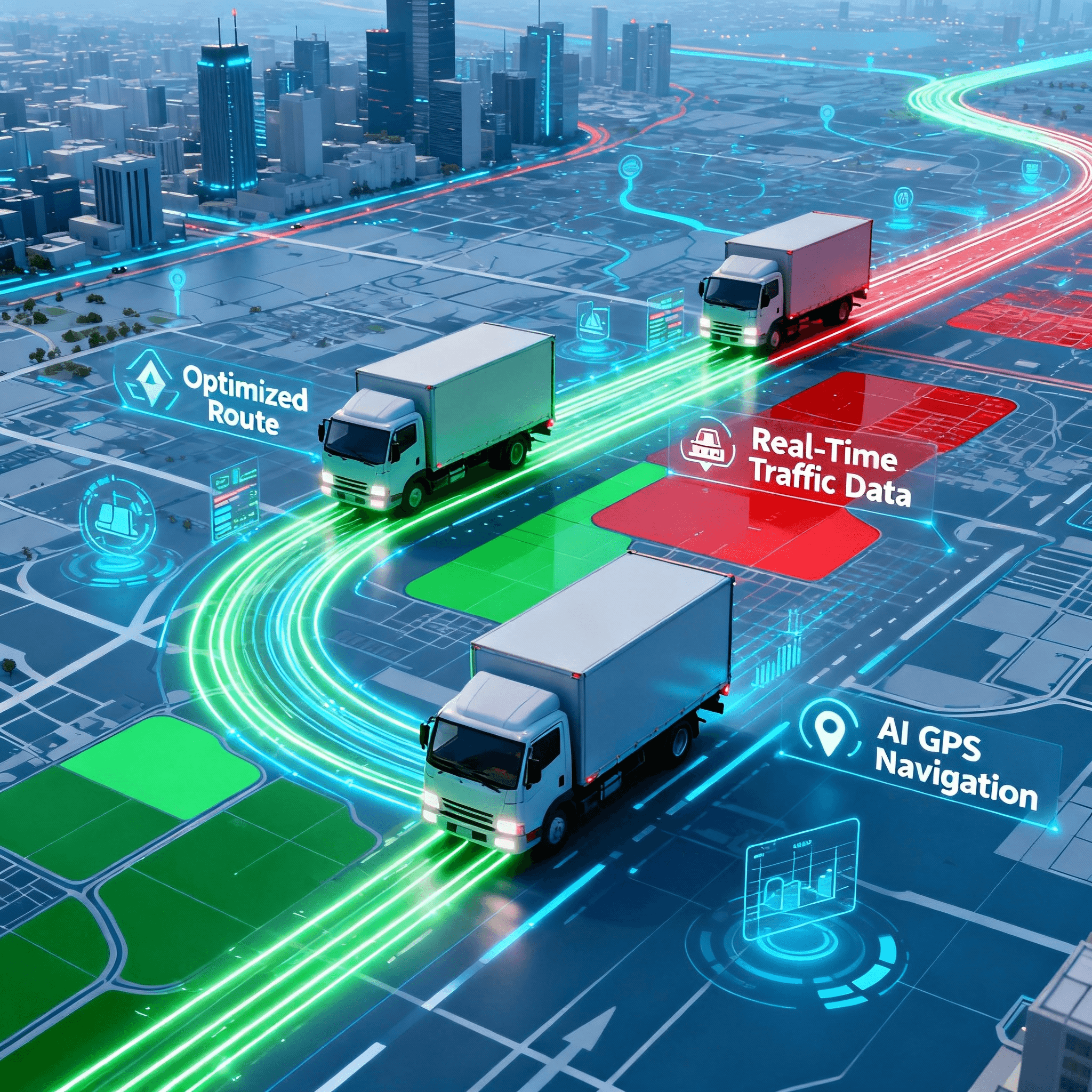Real-World Examples of AI Route Optimization in Logistics?
Sunday, 28 Sep 2025
|
Real-World Examples of AI Being Used for Route Optimization
Theory is compelling, but results matter. When discussing AI's transformative impact on logistics, nothing speaks louder than real-world success stories from industry giants who've deployed AI route optimization at massive scale—saving millions in fuel costs, reducing delivery times, and cutting carbon emissions.
From UPS's pioneering ORION system that optimizes 125,000 vehicles daily to Amazon's AI-powered delivery network handling millions of packages, these examples prove AI route optimization isn't experimental technology—it's operational necessity for competitive logistics.
Let's explore how leading logistics companies leverage AI routing to achieve measurable business outcomes that redefine industry standards.
Wondering what separates AI hype from AI results? These proven case studies reveal the strategies, technologies, and ROI behind successful implementations.
UPS: ORION - The Industry's AI Route Optimization Pioneer
The Challenge:
UPS delivers 20+ million packages daily across 125,000+ vehicles. Even small routing inefficiencies multiply into massive costs—every mile saved per driver per day translates to $50 million in annual savings.
The AI Solution: On-Road Integrated Optimization and Navigation (ORION)
Launched in 2013 and continuously refined, ORION represents one of the earliest and most successful large-scale deployments of AI in any industry.
Technical Architecture:
- 1,000 pages of sophisticated optimization code running on high-performance computing infrastructure
- 30,000 route optimizations processed per minute across the fleet
- Advanced reinforcement learning algorithms evaluating millions of potential route combinations for each driver daily
Data Integration:
ORION processes billions of data points from multiple sources:
- GPS and telematics data from 125,000+ vehicles
- Historical delivery records spanning decades
- Real-time traffic feeds from multiple services
- Dynamic weather conditions
- Fluctuating package volumes and delivery windows
The AI Learning Loop:
Data Ingestion: Continuous streams from vehicles, traffic services, weather systems, and customer orders
Decision-Making: Reinforcement learning evaluates millions of combinations considering delivery windows, traffic patterns, fuel efficiency, and operational constraints
Continuous Learning: Performance data from completed routes refines predictive models, making the system "smarter with every delivery"
Measurable Results:
- 100 million miles saved annually since full deployment
- 10 million gallons of fuel saved per year
- $300-400 million in annual cost savings
- Reduced CO2 emissions by 100,000 metric tons annually
- 1-3 fewer miles driven per route (seemingly small but massive at scale)
Strategic Insight: ORION's famous preference for right-hand turns (avoiding left turns across traffic) reduces idling time, fuel consumption, and accident risk—a counterintuitive optimization humans wouldn't naturally implement.
For insights into the algorithms powering ORION's success, explore Most Common AI Algorithms Used for Route Planning and Demand Forecasting.
Amazon: AI-Powered Last-Mile Delivery Network
The Challenge:
Amazon delivers over 8 billion packages annually with customer expectations for same-day or next-day delivery. Traditional routing couldn't scale to handle this volume with acceptable speed and cost.
The AI Solution: Integrated Route Optimization and Predictive Analytics
Amazon's AI routing system combines multiple technologies:
Dynamic Route Generation:
- Real-time route optimization adjusting for traffic, weather, and delivery density
- AI-powered clustering algorithms grouping deliveries by geographic proximity
- Predictive models forecasting optimal delivery windows based on customer availability patterns
Smart Package Sorting:
AI systems automatically route packages through fulfillment centers based on destination, urgency, and available transportation capacity—reducing manual sorting time by 70%+.
Autonomous Delivery Innovation:
- Scout robots for last-mile residential deliveries in select markets
- Prime Air drone program using AI for autonomous navigation and obstacle avoidance
- AI-powered delivery apps providing drivers with optimized stop sequences updated in real-time
Measurable Impact:
- 10% improvement in delivery efficiency through DeepFleet AI system
- 30% reduction in last-mile delivery costs in optimized markets
- 75% of deliveries now robot-assisted in advanced fulfillment centers
- Same-day delivery expanded to millions more customers through AI optimization
Learn how AI transforms warehouse operations supporting these routing capabilities in How Computer Vision Technology Helps in Logistics Operations.
FedEx: AI-Enabled Control Tower for Dynamic Rerouting
The Challenge:
Global logistics networks face constant disruptions—weather delays, customs issues, mechanical failures, traffic congestion. Traditional systems react after problems occur.
The AI Solution: AI-Powered Control Tower with Predictive Rerouting
FedEx deployed an AI-enabled "control tower" dashboard that monitors the entire network in real-time and proactively prevents disruptions.
Core Capabilities:
- Deep learning models predicting potential delays 48-72 hours before they occur
- Automated rerouting decisions executed without human intervention when confidence thresholds are met
- Multi-modal optimization balancing air, ground, and ocean transportation dynamically
- Predictive maintenance on vehicles and aircraft reducing unexpected breakdowns
Business Outcomes:
- 20% improvement in on-time delivery performance in optimized corridors
- 15% reduction in fuel consumption through dynamic route adjustments
- $200+ million annual savings from improved network efficiency
- Enhanced customer satisfaction through proactive delay communication
Understand the control tower concept in depth at What is an AI-Powered Control Tower in Logistics?.
DHL: AI Route Optimization for International Logistics
The Challenge:
International shipping involves complex regulations, customs requirements, and multi-modal transportation coordination across countries with varying infrastructure quality.
The AI Solution: Global Route Optimization Platform
DHL's AI system optimizes international shipments by:
Smart Route Selection:
- Evaluating thousands of potential routing combinations across air, sea, rail, and road transportation
- Predicting customs clearance times at different ports and border crossings
- Balancing cost, speed, and reliability based on shipment priority
Predictive Risk Management:
- Monitoring geopolitical events, weather patterns, and port congestion
- Automatically rerouting shipments away from high-risk corridors
- Providing customers with proactive delay notifications
Results:
- 12% reduction in international transit times
- 18% decrease in logistics costs for optimized routes
- 25% improvement in customs clearance efficiency
Walmart: AI-Powered Delivery Route Optimization
The Challenge:
Walmart manages one of the world's largest retail supply chains, requiring coordination between thousands of suppliers, distribution centers, and retail stores.
The AI Solution: Integrated Supply Chain and Delivery Optimization
Walmart's AI platform optimizes:
Inbound Logistics:
- Supplier pickup scheduling based on inventory needs and transportation availability
- Consolidation strategies combining shipments to maximize trailer utilization
- Dynamic carrier selection balancing cost and service level requirements
Last-Mile Delivery:
- AI-optimized routes for Walmart+ home delivery service
- Crowdsourced delivery optimization using gig economy drivers
- Real-time route adjustments responding to order changes and traffic conditions
Business Impact:
- $1+ billion in logistics cost savings annually
- 30% improvement in trailer utilization rates
- Delivery capacity increased by 35% without proportional cost increases
See how predictive capabilities enable these optimizations in How AI Improves the Accuracy of Demand Forecasting.
Key Success Factors Across All Examples
Analyzing these implementations reveals common success factors:
1. Comprehensive Data Integration
All successful implementations integrate diverse data sources—GPS, traffic, weather, historical performance, and real-time conditions.
2. Continuous Learning Systems
AI models improve with every delivery, creating compounding advantages over time.
3. Real-Time Adaptation
Systems dynamically adjust to changing conditions rather than following static plans.
4. Multi-Objective Optimization
Balancing competing goals—cost, speed, reliability, sustainability—rather than optimizing single metrics.
5. Human-AI Collaboration
Most successful systems augment human decision-making rather than replacing it entirely.
For foundational context on AI's role in logistics, visit What Exactly Is AI in Logistics and Supply Chain Management?.
ROI Metrics: What AI Route Optimization Delivers
Across these real-world implementations, consistent performance improvements emerge:
Cost Reduction:
- 15-25% fuel cost savings
- 10-20% reduction in total logistics costs
- 20-30% improvement in asset utilization
Performance Improvement:
- 20-30% increase in on-time deliveries
- 30-50% reduction in manual planning time
- 15-25% increase in deliveries per driver per day
Sustainability Gains:
- 15-20% reduction in carbon emissions
- 10-15% decrease in vehicle miles traveled
- Significant reduction in traffic congestion contribution
These results aren't theoretical—they're audited, verified outcomes from large-scale operations processing millions of deliveries daily.
How debales.ai Brings Enterprise-Grade Route Optimization to All Businesses
The examples above showcase Fortune 500 implementations requiring massive investment. debales.ai democratizes this intelligence for operations of all sizes:
Intelligent Route Planning: Multi-stop optimization considering traffic, delivery windows, vehicle capacity, and driver constraints
Real-Time Adaptation: Dynamic rerouting responding to traffic, weather, and operational changes instantly
Predictive Analytics: Forecasting optimal departure times, anticipating delays, and proactively preventing issues
Seamless Integration: Connecting with existing TMS, GPS, and operational systems without complex custom development
Explainable AI: Transparent reasoning showing why routes are recommended and what factors drive decisions
Understand how these capabilities integrate with broader supply chain intelligence in A Simple Analogy for How AI Optimizes a Supply Chain.
The Competitive Imperative
These examples aren't isolated success stories—they represent the new operational standard. Companies still relying on manual route planning or basic routing software face widening efficiency gaps against AI-enabled competitors achieving 20-30% better performance metrics.
The question isn't whether to implement AI route optimization—it's how quickly your organization can deploy it before competitive disadvantages become insurmountable.
Ready to achieve UPS-level routing efficiency for your logistics operations?
Discover how debales.ai's AI-powered platform delivers enterprise-grade route optimization accessible to businesses of all sizes—reducing costs, improving delivery performance, and cutting emissions.
Book a demo with debales.ai today and transform route planning from operational challenge into competitive advantage.
All blog posts
View All →
Friday, 28 Nov 2025
The 90-Day Roadmap: Moving from Ad-Hoc AI to Operational Excellence
Stuck in AI experimentation? Learn how to escape Level 2 maturity using the Mess-O-Meter to diagnose chaos, prioritize with triangulation, and scale in 90 days.

Thursday, 27 Nov 2025
Mess-O-Meter Deep Dive: Real Logistics Examples for Digital Maturity
Discover Mess-O-Meter examples diagnosing digital chaos in logistics—baseline workflows, benchmark maturity, create AI roadmaps with real steps for transformation success.

Wednesday, 26 Nov 2025
Multi-Agent AI via Email: End-to-End Automation for Logistics Complexity
Explore agentic orchestration where autonomous email AI agents coordinate freight, customs, insurance, and carriers—automating multi-party processes for resilient supply chains.